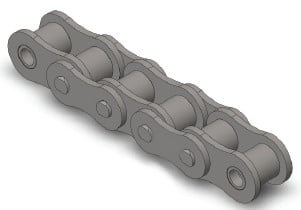The next methods should really be employed to pick chain and sprocket sizes, identify the minimal center distance, and calculate the length of chain needed in pitches. We’ll generally use Imperial units (this kind of as horsepower) in this segment however Kilowatt Capability tables are available for each chain dimension in the preceding section. The assortment approach would be the very same irrespective with the units employed.
Step 1: Identify the Class from the Driven Load
Estimate which from the following ideal characterizes the issue on the drive.
Uniform: Smooth operation. Tiny or no shock loading. Soft get started up. Moderate: Normal or reasonable shock loading.
Heavy: Extreme shock loading. Regular begins and stops.
Stage two: Determine the Services Issue
From Table 1 below ascertain the appropriate Service Issue (SF) for your drive.
Stage 3: Calculate Style and design Energy Necessity
Design and style Horsepower (DHP) = HP x SF (Imperial Units)
or
Style and design Kilowatt Electrical power (DKW) = KW x SF (Metric Units)
The Style Electrical power Requirement is equal to your motor (or engine) output electrical power times the Services Issue obtained from Table 1.
Phase 4: Create a Tentative Chain Choice
Make a tentative selection of the expected chain size within the following manner:
1. If working with Kilowatt electrical power – fi rst convert to horsepower for this phase by multiplying the motor Kilowatt rating by one.340 . . . This is required because the  speedy selector chart is shown in horsepower.
speedy selector chart is shown in horsepower.
two. Locate the Design and style Horsepower calculated in phase three by reading through up the single, double, triple or quad chain columns. Draw a horizontal line by this value.
three. Locate the rpm in the small sprocket to the horizontal axis with the chart. Draw a vertical line via this worth.
four. The intersection of the two lines should indicate the tentative chain variety.
Phase 5: Choose the number of Teeth for the Tiny Sprocket
The moment a tentative choice of the chain dimension is produced we have to figure out the minimal amount of teeth demanded around the compact sprocket needed to transmit the Style and design Horsepower (DHP) or the Style Kilowatt Power (DKW).
Stage six: Determine the number of Teeth for your Huge Sprocket
Utilize the following to determine the amount of teeth for your large sprocket:
N = (r / R) x n
The number of teeth about the massive sprocket equals the rpm in the small sprocket (r) divided through the sought after rpm of your large sprocket (R) instances the quantity of teeth on the tiny sprocket. Should the sprocket is also large for that space out there then several strand chains of the smaller pitch must be checked.
Step seven: Figure out the Minimum Shaft Center Distance
Utilize the following to calculate the minimum shaft center distance (in chain pitches):
C (min) = (2N + n) / 6
The above is often a guidebook only.
Step 8: Check out the Final Variety
Additionally bear in mind of any potential interference or other space limitations that may exist and adjust the assortment accordingly. Generally probably the most efficient/cost eff ective drive makes use of single strand chains. This really is due to the fact a number of strand sprockets are far more high priced and as can be ascertained by the multi-strand variables the chains turn into significantly less effi cient in transmitting power since the quantity of strands increases. It can be as a result typically finest to specify single strand chains when doable
Stage 9: Figure out the Length of Chain in Pitches
Use the following to calculate the length in the chain (L) in pitches:
L = ((N + n) / 2) + (2C) + (K / C)
Values for “K” may very well be found in Table four on page 43. Try to remember that
C will be the shaft center distance given in pitches of chain (not inches or millimeters and so on). When the shaft center distance is acknowledged in a unit of length the worth C is obtained by dividing the chain pitch (while in the identical unit) by the shaft centers.
C = Shaft Centers (inches) / Chain Pitch (inches)
or
C = Shaft Centers (millimeters) / Chain Pitch (millimeters)
Note that every time achievable it’s greatest to use an even quantity of pitches as a way to avoid using an off set hyperlink. Off sets will not possess the same load carrying capacity since the base chain and ought to be avoided if possible.